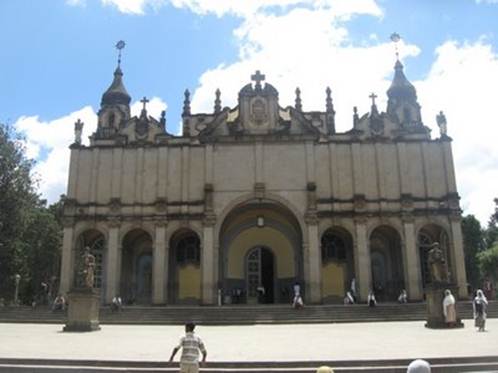Pray
Religion is part and parcel of daily life
here. To really feel part of it, you need to get up early. In Bahir Dar I was
up and out by 5am, in time to hear the call to prayer from the mosque and to
see the Orthodox Christians appear, wrapped in white muslin, in the dusk as
they made their way to church to say their morning prayers. At Debre Zeit I
walked up a hill at sunrise to the Orthodox Church in the local village and was
in time to see the villagers perform this morning ritual. It was brief – a
touch, a bowed head and a prayer at the shrine outside the church – but it was
clear that this is how they have begun their days for centuries.

the
Orthodox Christians
One of the biggest tourist attractions, and a
UNESCO World Heritage Site, is the 11 rock-hewn churches at Lalibela, a
dirt-poor mountain village eking out a living from tourism and subsistence
farming. Flying to this popular town on Ethiopia’s ‘religious route’ has its
own reward: breathtaking views of the Rift Valley. With our guide, Waceh, who
is surely the coolest deacon in Africa, we visited four of the churches near
the town. All 11 churches have been chiselled by hand from single monoliths or
hewn from the vertical limestone cliff faces, a process that took more than 20
years per church. The last one to be carved out, and the most beautiful, is St.
George’s which has its floor over 12 metres below ground level. Although King
Lalibela built all the others, St. George’s was built by his window in his
memory. The perfect geometry and symmetry make it striking in its simplicity.
But what struck me most about these miracles of determination, devotion and
craftsmanship is that these 13th century places of worship are used as churches
to this day. In fact, the footpath to St. George’s passes a handful of tukels
(stone and thatch huts) that make up a school for young boys aspiring to be
monks.

a
UNESCO World Heritage Site, is the 11 rock-hewn churches at Lalibela
Similarly, 19 monasteries scatered around the
37 islands in Lake Tana are also still in use and home to small communities of
monks. The path to the 14th century Ura Kidane Mehret on Zege peninsula is
uphill and uneven, and the monastery is a round mud and straw building that has
survived unbelievably well. The brightly coloured, well-preserved frescoes are
astounding – and with no visible protection other than a request not to use
flash photography.
More than once I was pleasantly surprised by a
young, modern Ethiopian’s display of religiousmess: one girl who escorted our
group wherevr we went wore body-hugging mini-dresses every day but had a cross
on the back of her BlackBerry and prayed devoutly at all the churches we
visited. Orthodox Christianity and Islam – by far the biggest religions amond
Ethiopia’s 80 million people – live side by side and are a matter of course as
the people go about their business.

the
League of Nations
Although not a deity, Emperor Haile Selassie
is respected and revered by many. He was nowhere near perfect but as the 225th
and last emperor of the 3 000-year-old monarchy, he did manage to lead the
country into the 19th, if not the 20th, century. He also called the first
meeting of the Organisation of African Unity (today’s African Union) in 1963.
Selassie completed construction work on the Cathedral of the Holy Trinity, one
of Addis Ababa’s undeniable attractions and the site of his eventual resting
place, after the Italian accupation in 1942. The murals depicting his return to
Ethiopia from exile and address to the then League of Nations sitting alongside
the typical religious ones are an indication of Selassie’s place in Ethiopian
history.